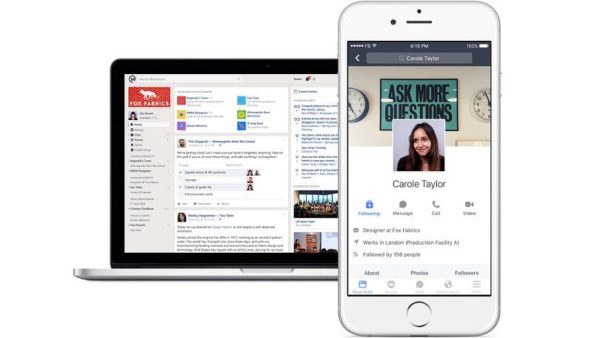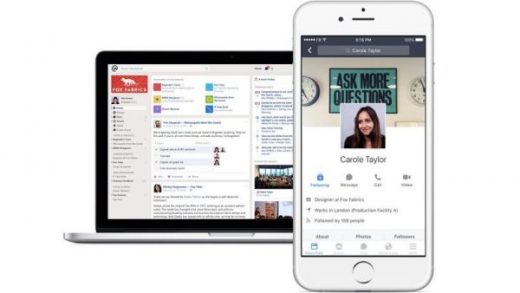Can Facebook Workplace Kill Office Email?
— December 29, 2016
A new wave of online collaboration software is threatening to dramatically reduce (if not eliminate) intra-office email communication. Products such as Slack, Microsoft Teams, and Facebook Workplace let business users chat via text and video conference, send GIF files and emojis, and even share files—all without leaving the comfort of a web browser or local application.
If you’re not familiar with this form of collaboration software, then check out our article on the difference between Slack and Microsoft Teams. In it, you’ll find a host of the best features available on both of these industry-leading platforms as well as each platform’s unique distinguishing features.
In this article, we’ll look specifically at four features of Facebook Workplace, an intriguing new business collaboration suite, and examine why it could replace most intra-office email. For those of you who’ve never used Facebook Workplace (and neither have we), don’t fret: Workplace appears to be almost identical to the Facebook you use in your personal life. In fact, if your business adopts the software, then you’ll likely find yourself inundated by a similar stream of baby and cat photos. That’s what appears to be so perfect about the tool (and Microsoft Teams and Slack): it replicates a tool you use in your daily life but it provides your business with the control and authority to guide conversations back to work.
We will also examine whether Workplace (and, by default, Microsoft Teams, and Slack) could ever replace email for external communications. Spoiler alert: Probably not (at least not yet).
1. Groups
Email is easy enough to use but conversations can become overwhelming, especially when too many users are on one thread. When it comes to email threads, think about how often multiple people respond to the same email simultaneously, reply to one person instead of the entire thread, or reply to everyone instead of the one intended recipient.
With Facebook Workplace, you can use the tool’s Groups feature to gather relevant employees into a single thread where they’re free to chat with one another in a public forum, attach large files for those workers who would like access, and even search for old threads the way you’d search your email inbox for old conversations.
Workplace even lets you create multi-company groups that let you collaborate with other Workplace teams. This is especially useful for advertising teams who are working with external clients and service teams who are working with white-glove accounts, for example.
2. News Feed
We all know how easy it is to miss a company-wide email. Either we’re too busy or we’re in a rush, and we decide to open the message later and then later never happens. With Workplace, employees are immediately presented with a News Feed that presents the most important stories of the day. Not only will the CEO’s message trigger a notification when it’s posted but it will likely live at the top of your feed, and you’ll be able to see everyone’s responses to the message. This is a much more transparent, much more user-friendly way to post, read, and respond to messages.
Additionally, more important posts are given more weight than less significant posts, which means that you’re automatically more likely to see what you need to see. With email, every message is given equal weight until you weigh in on the message’s importance.
Hate what you’re seeing on Workplace? Unfollow the thread or delete the post—both options are better than sending a company-wide message saying, “Take me off this damn email thread.”
3. Live Broadcasting
We’ve all seen live videos from major media companies such as The New York Times, NBC, and, of course, PCMag but you can broadcast live directly within Facebook Workplace, too. This is a nifty feature that’s useful for serious business as well as group-bonding activities. Is your CEO speaking at a conference? Broadcast the keynote live to everyone who wasn’t able to attend. Is your PR team taking the Ice Bucket Challenge? Join them from a safe, warm distance by viewing the live video.
No email platform is going to provide you with that level of functionality and immediacy. With email, you’ll need to record the video, save it to your desktop or streaming service, and then share it via mass email message with everyone in the company. This is a slow, multi-step, early 2000s way of sharing content with your coworkers.

4. No Spam
No matter how strict your company’s email filters are, you’ll undoubtedly be flooded by spam. On the other hand, Facebook Workplace is a closed community that only registered employees and partners can access. Sure, you might see too many memes and political links on Workplace, but at least you can publically shame your coworker out of this practice. With spam, the messages will continue to arrive in your inbox regardless of how loudly you scream.
A Dose of Reality
Let’s be honest: Email isn’t going anywhere. Collaboration apps are never going to kill email for external communications. Your IT team isn’t going to be able to onboard everyone outside of your company who requests access to your internal group in order to send you a direct message. That’s not feasible, prudent, or cost-effective (Facebook Workplace begins at $ 3 per user).
If people were more inclined to use telephones than they are, then perhaps a combination of collaboration app for internal messaging and voice calling for external communications would do the trick. Unfortunately, no one really wants to answer every single call that comes across their desk. People also hate logging into their voicemail. It’s much easier to monitor emails and answer only those messages that you choose to answer.
For marketing communications, no medium is as easy or cost-effective as email. Think about how annoyed you’d be if every commercial email message that went to your inbox was instead delivered via phone call or text message. God forbid. Thankfully, email remains the perfect platform for external communicators to send pitches, to offer coupons, and to ask how best they can serve you.
However, it’s only a matter of time before one of the collaboration platform manufacturers creates a seamless way for outsiders to reach users without disrupting the internal platform ecosystem. For example, if you could receive a chat message in Workplace without IT having to grant Workplace access to the sender (while also maintaining the security of the system and without allowing the outsider access to any of the platform’s internal threads or groups), then I see no reason why email couldn’t be eradicated completely. If you’ve got any idea about how to solve these issues, then send me a message (on the platform of your choice).
Facebook declined to comment on this story.
Digital & Social Articles on Business 2 Community
(24)


